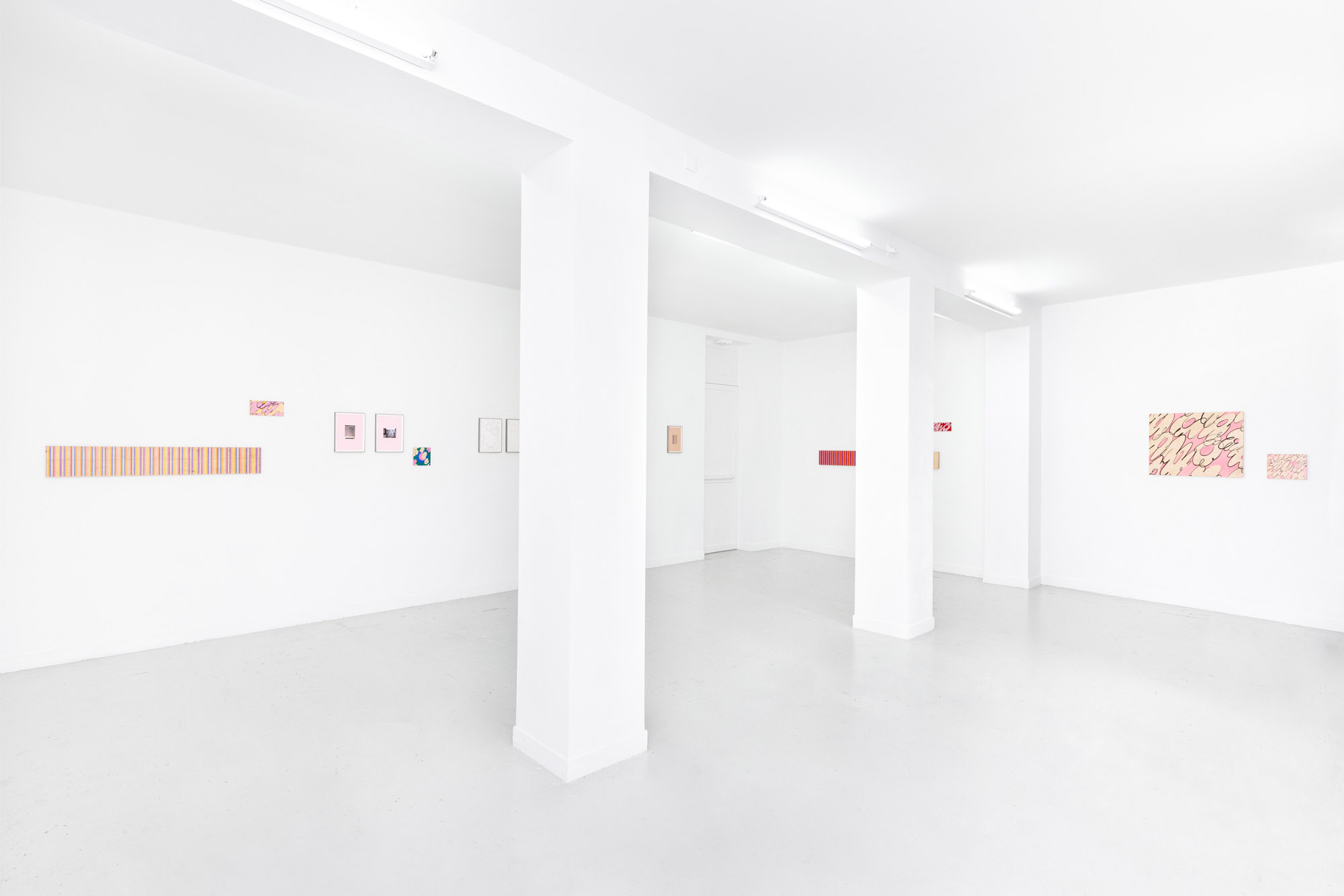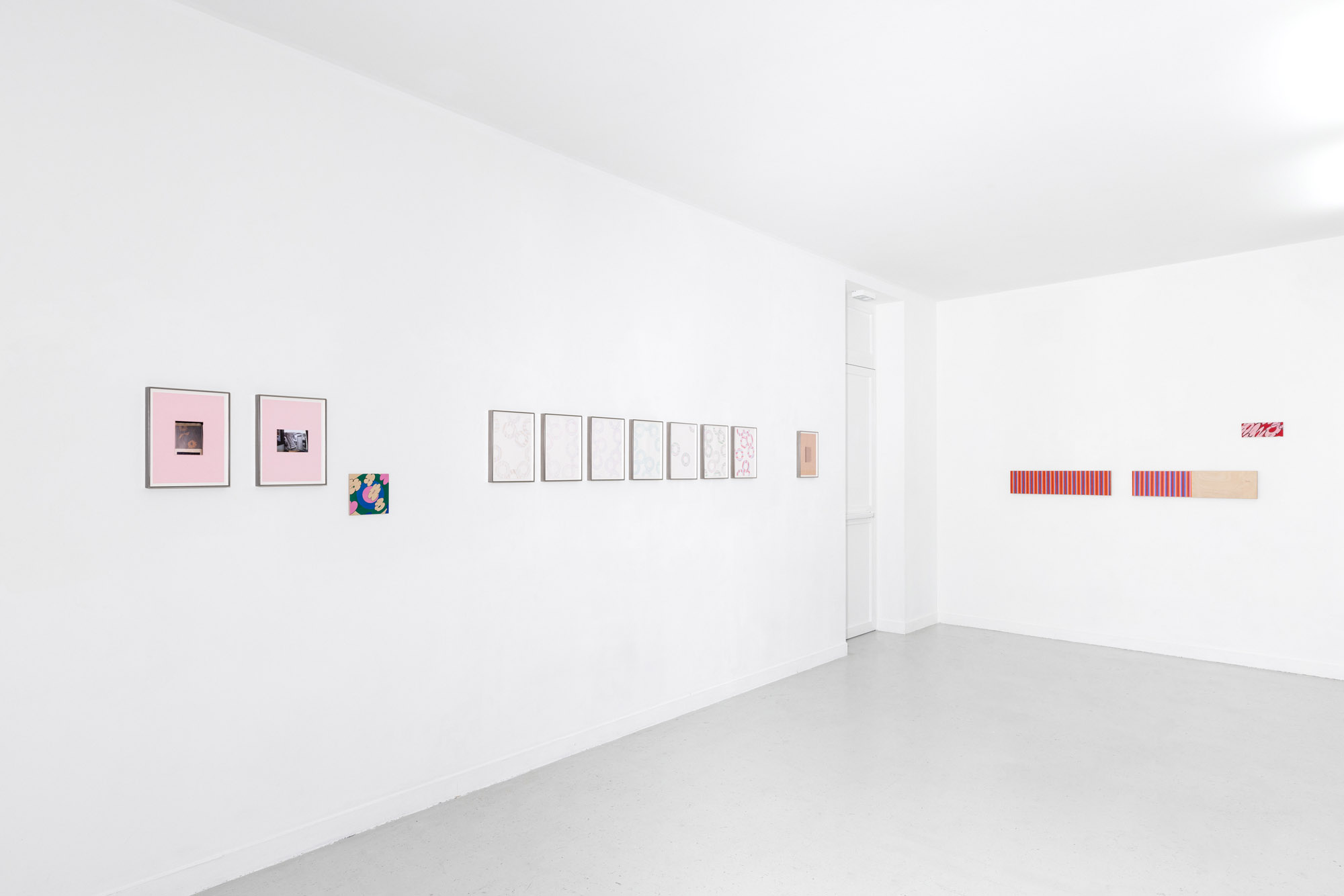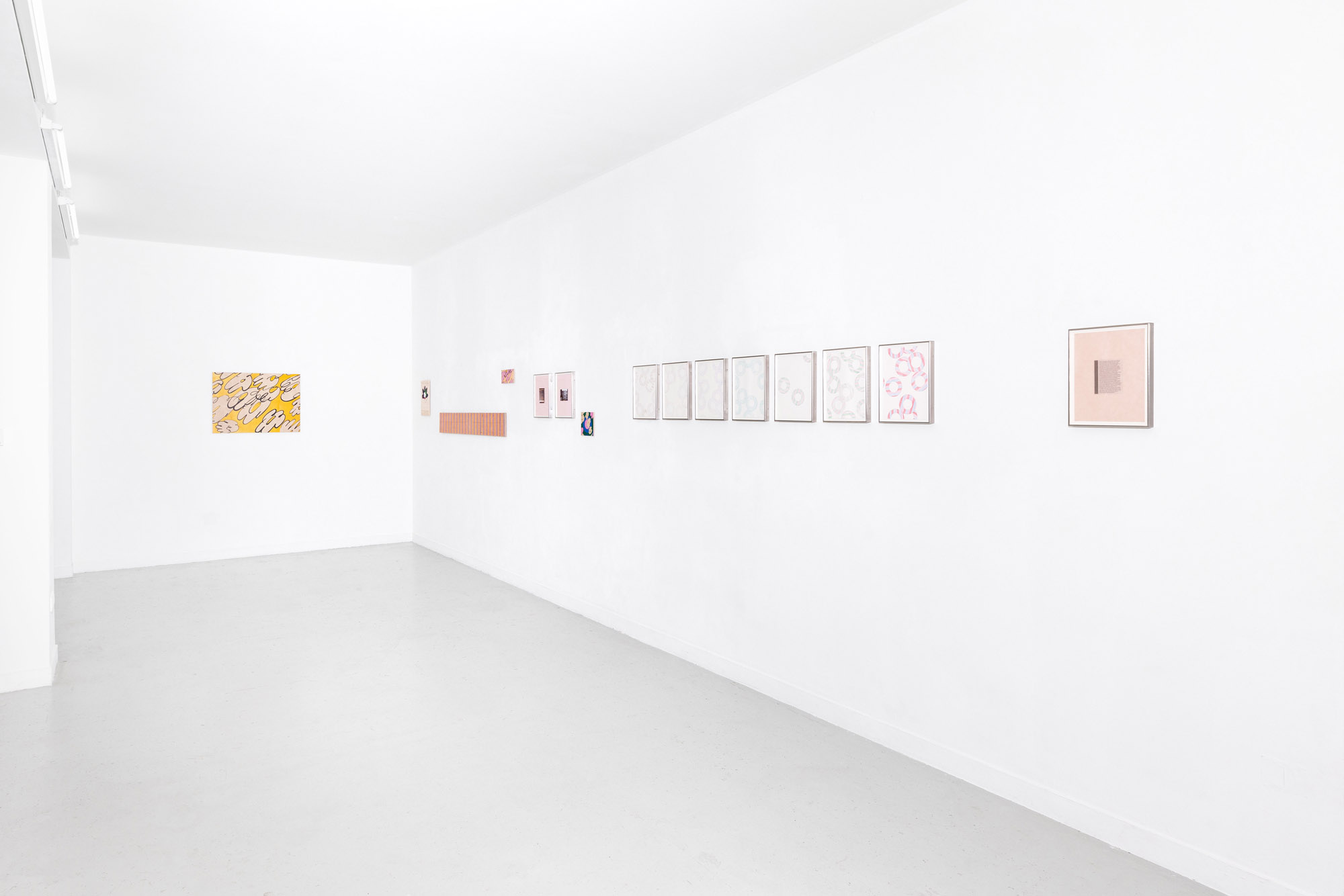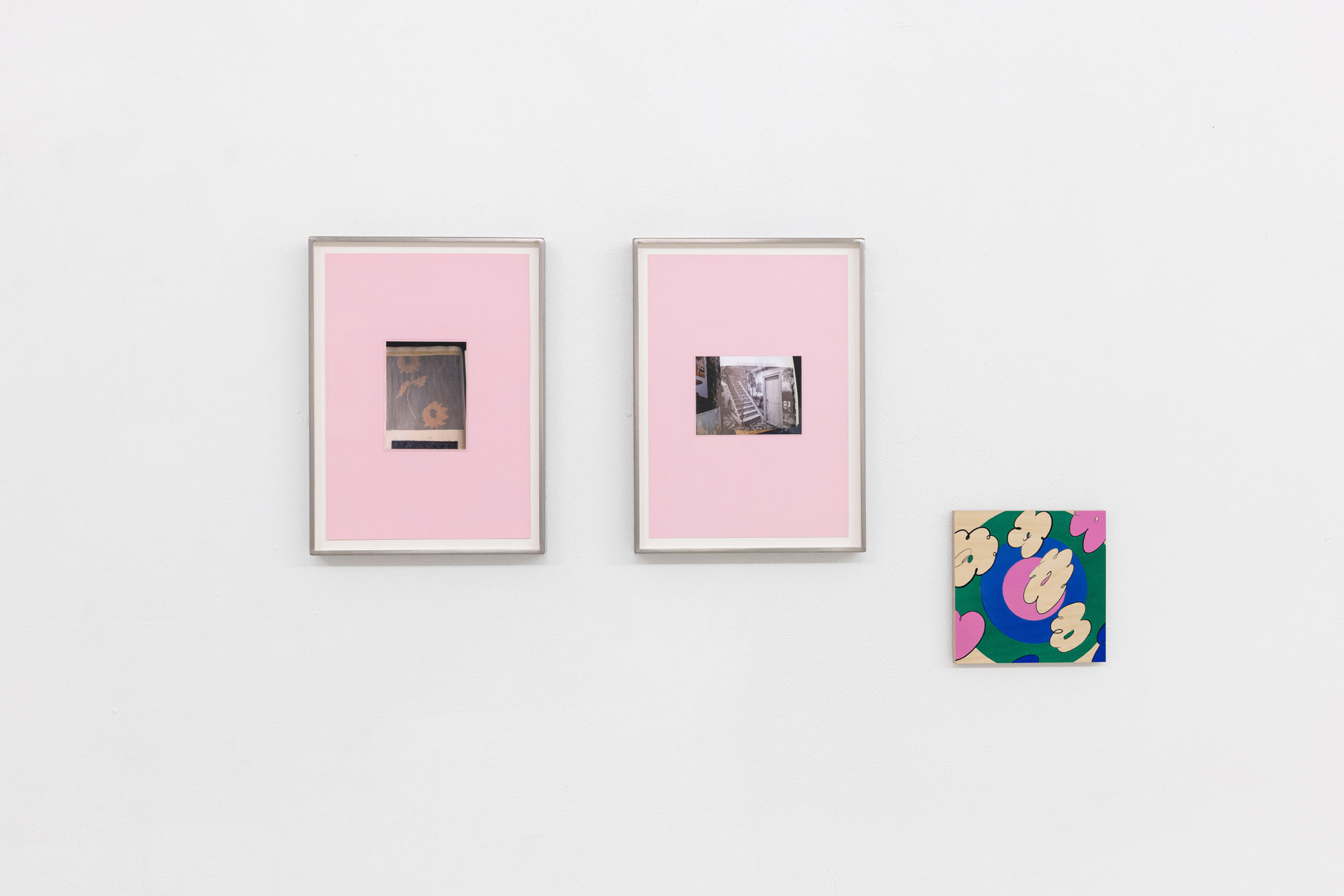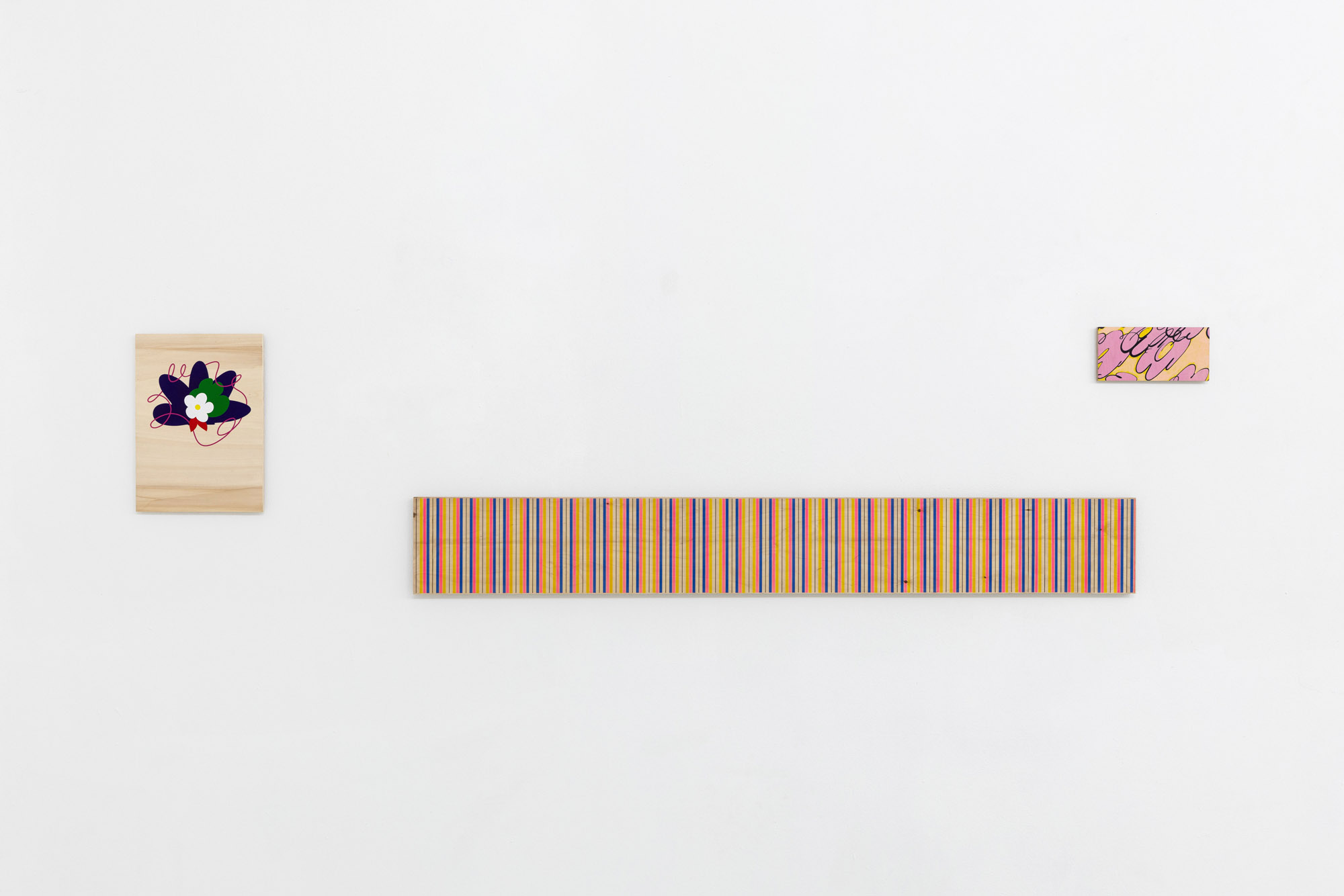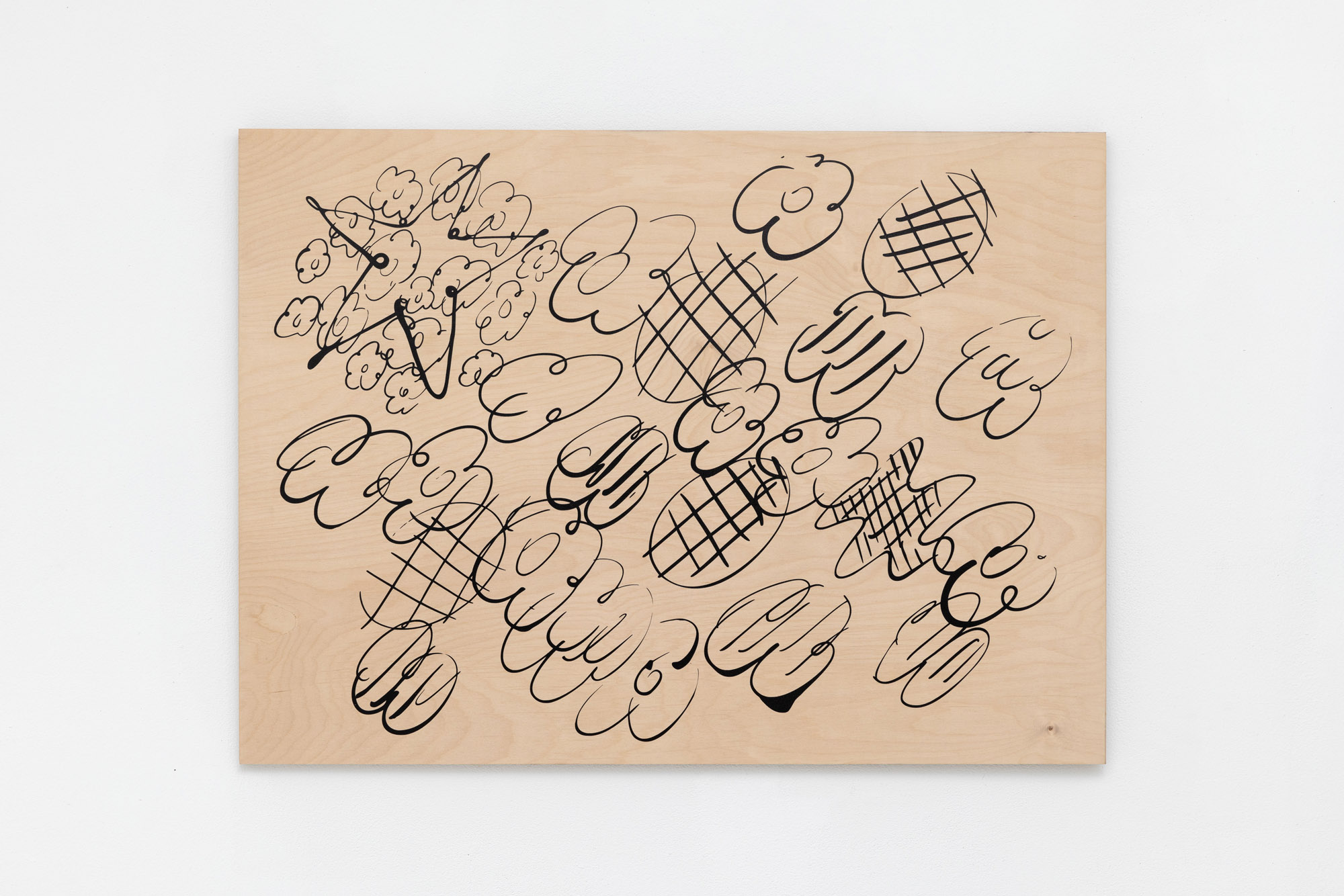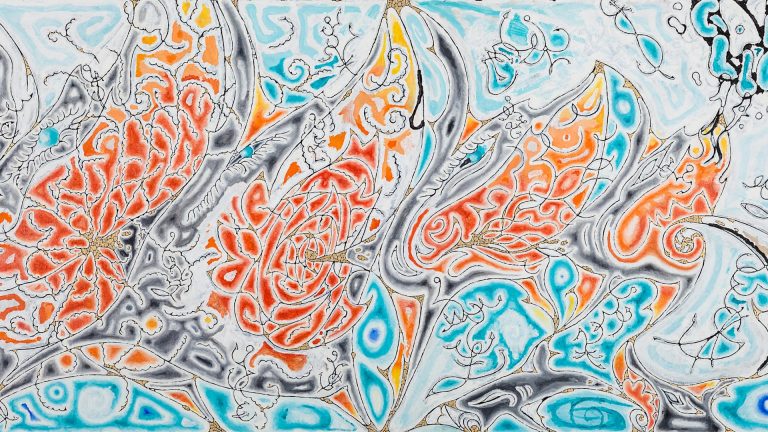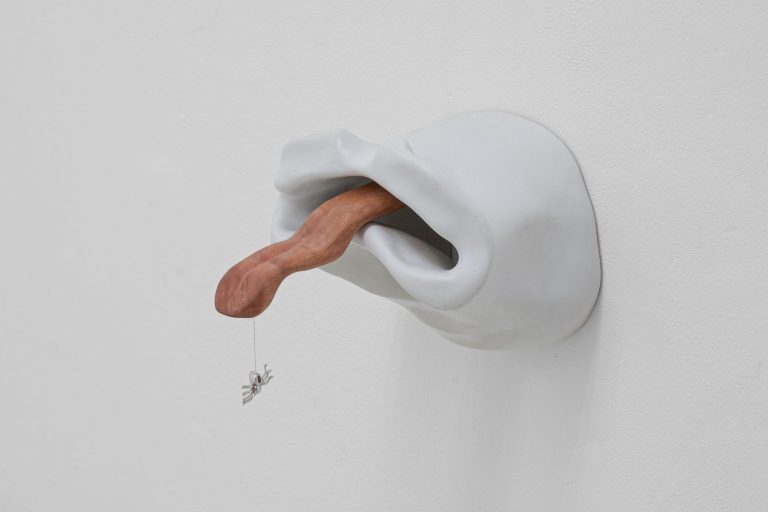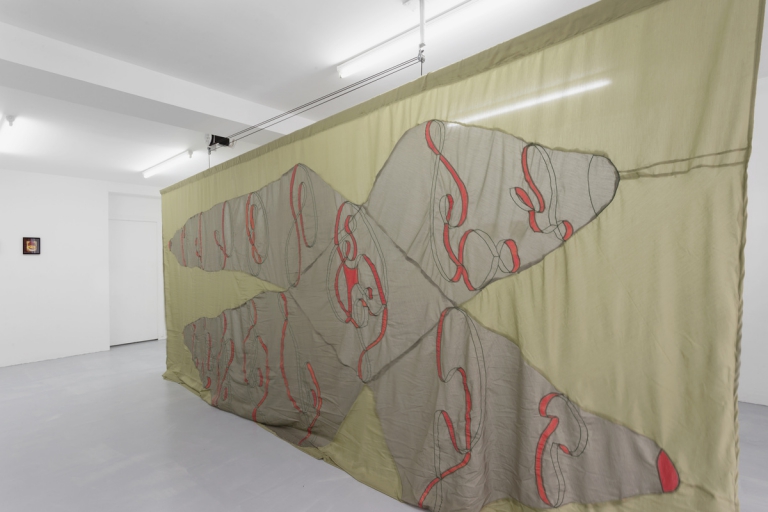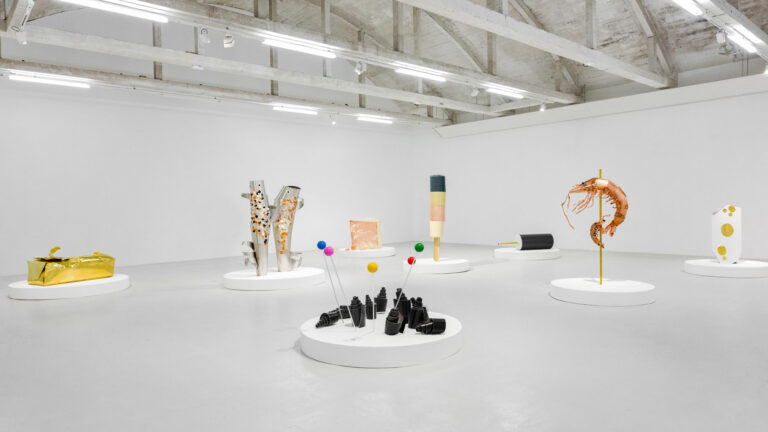Artist: Noémie Bablet
Exhibition title: Tenue de promesse
Venue: Les Bains-Douches, Alençon, France
Date: November 4 – December 21, 2022
Photography: Romain Darnaud / all images copyright and courtesy of the artist and Les Bains-Douches, Alençon
– Tenue de promesse: this title makes me think of an anecdote told by the artist Lily Van Der Stokker in her book How I Went to New York: 1983-1992. While she is known for her bright candy-colored wall paintings, she went to the opening of her own exhibition wearing the wrong pants. A plain orange pair, instead of her usual floral pants, which, she quickly realized, exacerbated the uneasiness she felt about attending this social event in the first place. In addition to its comforting honesty, this story is all the more funny and surprising because here this artist accustomed to flaunting exuberant colors suddenly experiences serious color discomfort. As if her taste had, at this precise moment, betrayed her, or as if she were not – socially – up to it. What could be more embarrassing than wearing something that does not make you look good in the eyes of others, even though it promised to be positively smashing?
– I really like this story. It talks about the sense of discomfort or impeccability produced by an outfit, when what we wear is not just a question of cloth but also of behavior, as the title suggests. (An open-ended play on words, it can mean “keeping a promise,” “a promising outfit,” or “promising conduct.”) There’s a line from the poet Rae Armantrout I like a lot: Behavior is a pile of clothes I might or might not wear.
– For me the reference to Lily Van Der Stokker is all the more fitting because you’ve looked at her work a lot, haven’t you? We could easily start by talking about your aesthetic affinities: a certain taste for decorative patterns, strong colors, a deliberate false naivety…
… the inclusion of biographical motifs in one’s work, a drawing’s potential to be enlarged… she’s an important reference for me, that’s true.
– But to me this para-artistic story says a lot about your exhibition at the Bains-Douches. I have the impression that you’re not afraid to show an excessive taste for motifs while deploying them in such a way that they never become easy arrangements.
– I’m not sure I agree with that, but I do arrange shapes and colors to construct compositions so that the result is… exciting? Likewise, the laminated cards and the colored backgrounds I put them on are precisely chosen so that everything comes together as a coordinated whole.
– Before making a painting, there is a drawing phase, which you described as “a time for quick, light thinking” that you try to carry out with your hands. Does that mean that you don’t think it through before that?
– No, just the opposite. During this preparatory drawing phase I can use any tool I want. It’s a phase for the settling out of all the images I’ve researched during the last few months, including at La Piscine, the arts and industry museum in Roubaix, where I consulted their collection of textile sample books from the nineteenth and twentieth centuries. It’s a moment of pleasure and freedom, and at the same time an exercise in exploration through drawing. I know exactly what I’m selecting and what I’m developing from one drawing to the next. First I develop possibilities, then I start to eliminate them. It’s very conscious and full of intense thinking.
– … so you choose which of these drawings to enlarge and paint. Here there are flowers with a heart and round petals sketched with a single stroke. Then you make a series of transformations. The drawings are scanned, vectorized, made into stencils, affixed to prepared wood and then painted. This is an extremely long process. Should we describe it in more detail?
– I don’t know if I want to talk more about the process. It’s just as interesting if people don’t know anything about it. When Sophie Vinet was looking at my paintings, I remember her telling me that the result seemed falsely simple, but it was clear that the process was not that simple at all.
– Actually, the appearance (or rather reappearance) of these cartoonish little flowers is postponed, as if you were trying to master the freshness and spontaneity that gave birth to them when you first drew them. The image has been optimized, impeccably cropped and matted, almost aggressive in its tones and its irreproachability. Encapsulated, encircled, these floral shapes are also carefully isolated and held back so that they can never achieve their potential as tapestry.
– Yes, I’ve done many drawings of motifs contained within circles. These circles are a link to my previous exhibition Credits and symbolize, for me, the polysemy of that word (esteem, financial backing, source references). But what do you mean when you say they are held back from fully becoming a tapestry?
– That these patterns are not intended to fill a given space, to connect with one other. Like these hand-drawn, stripped, colored rings that are aligned but never connect. There is no purpose to their reproducibility. They have been inspired by books about the history of Japanese textile patterns in the 1950s, designs used to make vintage handkerchiefs and tartans and yet they never get close to looking like fabric. As if they refused to become wearable, lived in.
– Well. I do want them to be fairly decorative, and I find houses are a good place for images and artworks. I like the idea of living with them, which is why there’s a reference in the show to the Charleston Farmhouse and the Bloomsbury Group. I often talk about the book Tell it to my heart: collected by Julie Ault, where she describes how she acquired her collection and how the artworks were photographed in their domestic environment. Furthermore, I would have no objection to adopting them for clothes; I’ve wanted to collaborate and continue my explorations in fashion collections.
– That’s funny, because just the other day I passed a store window displaying a line of clothing called “Late Bloomers”– one of the titles you originally considered for this show. Many of the laminated cards you selected from your collection for the exhibition feature artists, like Daan Van Golden and Pati Hill, whose practice based on decorative motifs, textiles and their encapsulation was slow to gain recognition.
– It’s interesting to note that Daan Van Golden and Pati Hill’s careers were not discreet in the same way, nor for the same social and financial reasons. I’m very interested in such questions: why and how does an artist decide whether to stop or continue working.
– Holding back these patterns over time, keeping them from completely blooming – isn’t that a way to give a slight twist to the fascination for the kind of pomp that only people who are very much at ease can pull off; and rather remain closer to their elaboration? Maybe these paintings are for people who love patterns and color but would never dare wearing them, in public, at least.
– Maybe it’s not so much about a fear of being seen in public or not daring to do so, as about being able to take part in the show, in shows in general. While the motif of time, keeping going for the duration, is important here, equally important is the question of continuity in one’s work. Then Tenue de promesse is the promise to keep on working, while being supported personally, socially, institutionally and financially.
-Noémie Bablet & Elsa Vettier
Noémie Bablet, Tenue de promesse, 2022, exhibition view, Les Bains-Douches, Alençon
Noémie Bablet, Bragging around, 2022, acrylic on wood, 58 x 80 cm; Noémie Bablet, Still bragging around, 2022, acrylic on wood, 21 x 30 cm, 2022
Noémie Bablet, Tenue de promesse, 2022, exhibition view, Les Bains-Douches, Alençon
Noémie Bablet, Outdoor introvert, 2022, acrylic on wood, 20 x 175 cm
Noémie Bablet, Signs of excitement (red), 2022, acrylic on wood, 10 x 24 cm
Noémie Bablet, Tenue de promesse, 2022, exhibition view, Les Bains-Douches, Alençon
Noémie Bablet, Tenue de promesse, 2022, exhibition view, Les Bains-Douches, Alençon
Noémie Bablet, Tenue de promesse, 2022, exhibition view, Les Bains-Douches, Alençon
Noémie Bablet, (No) (More) Credits, 2022, colored pencils on paper, 7 stainless steel frames 24 x 33 x 3 cm
Noémie Bablet, Sans titre (Motif 480), 2022, Laminated inkjet printing, stainless steel frame, 24 x 33 x 3 cm; Noémie Bablet, Sans titre (William Price), 2022, Laminated inkjet printing, stainless steel frame, cadre inox, 24 x 33 x 3cm
Noémie Bablet, Bloomy loons, 2022, acrylic on wood, 16 x 16 cm
Noémie Bablet, Indoor extrovert, 2022, acrylic on wood, 20 x 150 cm
Noémie Bablet, Tenue de promesse, 2022, exhibition view, Les Bains-Douches, Alençon
Noémie Bablet, Intimidation, 2022, acrylic on wood, 58 x 80 cm
Noémie Bablet, Excitement, 2022, acrylic on wood, 58 x 80 cm


